#chlorophyll molecule
Explore tagged Tumblr posts
Text

TSRNOSS. Page 125.
#harpoon#superoxide dismutase#algae#photophobic#singlet oxygen#oxalate crystal#plant#polarizability#scattering of light#chlorophyll molecule#polymer#Florey temperature#Theta temperature#rhodopsin#Rayleigh scattering#cursive#handwriting#manuscript#diaries#notebooks
1 note
·
View note
Text

SAVE THIS ONE. 🌱
Chlorophyll is on the top of the list when it comes to disease-fighting micronutrients.
What is chlorophyll?
CHLOROPHYLL is the compound in plants that is responsible for their green color. It also helps plants absorb energy from the sun (photosynthesis).
Why is Chlorophyll so important?
When we metabolize this powerful micronutrient from green foods it helps to cleanse our blood by separating our red blood cells, making our blood more free-flowing much like water (alkaline) instead of sluggish (acidic). When our blood is more fluid it can flow easily. In addition, chlorophyll oxygenates our blood which alkalizes our blood, tissues, and body. This is the healthy, healing environment we want to strive for. This is especially important for those diagnosed with cancer.
More oxygen (less inflammation)
= Alkaline (less acidity)
= Healthy, healing environment
SOURCES: spinach, kale, romaine lettuce, arugula, broccoli, spirulina, parsley, alfalfa, green beans, kiwi, green grapes, nettle sprouts 🥬🥝🥦
References:
Molecules: doi.org/10.3390/molecules28145344
Amy Myers MD: amymyersmd.com
SnyderHealth.com: snyderhealth.com
Verywell Health: verywellhealth.com
#anticancer#cancer#cancerfighting#chlorophyll#greens#disease#diseasefighting#inflammation#antiinflammatory#oxygen#cellhealth#alkaline#alkalinediet#alkalinefoods#superfoods#plantbased#vegan#healthy#health#diseaseprevention#immunity#immunesupport#immuneboosting
63 notes
·
View notes
Text

Fast Fauna Facts #25 - Pinnularia (Pinnularia spp.)
Family: Pinnularia Family (Pinnulariaceae)
IUCN Conservation Status: Unassessed
Found mainly in freshwater but also in marine environments and occasionally in damp terrestrial habitats, the members of the genus Pinnularia are diatoms - single celled organisms characterised by their protective silica-based glass-like cell walls known as frustules. Like plants diatoms sustain themselves entirely through photosynthesis and absorb sunlight via deposits of the green pigment chlorophyll in their cell bodies, and as the glass-like transparent structure of a diatom's frustule protects it from predators and adverse environmental conditions while still allowing sunlight to reach the cell's chlorophyll. Like plants diatoms also need certain inorganic molecules (mainly carbon and hydrogen to act as reactants during photosynthesis and nitrogen to produce proteins such as chlorophyll) to survive, and Pinnularia species these are taken in through tiny pores that run through the frustule.
-----------------------------------------------------------
Image Source: Here
<-Previous (Snow Scorpionfly) l Next (Archimylacris) ->
#fast fauna facts#pinnularia#diatom#diatoms#microbiology#biology#marine biology#wildlife#microorganisms
23 notes
·
View notes
Text
Default color of deciduous leaf is actually YELLOW. (from ever-present carotinoids, the “makes carrot orange and banana yellow” molecule). This is MASKED for most of its life by green (chlorophyll), and revealed when leaf starts ramping down photosynthesis.
RED is the only pigment that’s actually MADE in the fall (anthocyanins, from sap sugars, the “makes cherry red”molecule), and unlike yellow or green, must be distributed throughout the leaf, leading to the veiny patterns of color on some reddening leaves!
A red (or yellow, but mostly red) leaf can: mimic poisonous plants and animals, discouraging things like over-winter aphid infestations; highlight the presence of fruits and insects, encouraging birds et al to eat them; protect a non/low-photosynthesizing leaf from light overload while the tree reabsorbs its nutrients, ETC.
The balance of these benefits differs from local ecosystem to local ecosystem, tree to tree, leaf to leaf!
In the end, leaf turns BROWN from increased production of TANNINS (“makes wine bitter” molecule).
——
Source: Let’s Learn Everything! podcast, ep 74: Autumn Leaves and Swearing (with extensive source notes)
7 notes
·
View notes
Text
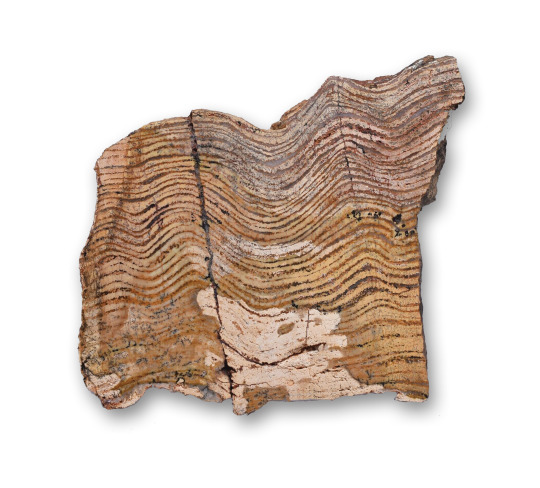
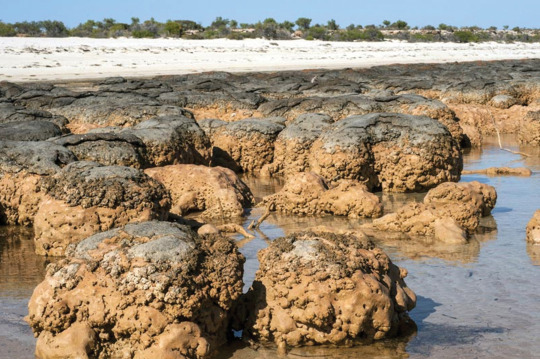
Stromatolites
3.5 billion years ago life first appeared along the water's edge as single-celled organisms called cyanobacteria (sī-an-nō-back-tir’-ē-ah). This is how the Archean Eon got it’s name, derived from the Greek word arkhē, meaning “the beginning.” Cyanobacteria did not require oxygen for sustenance, but instead relied on carbon dioxide and a green pigment called chlorophyll (klor'-eh-fil) to survive. Cyanobacteria use chlorophyll to absorb and store the sun's energy within it’s molecules to power the conversion of carbon dioxide and water into carbohydrates for food. During this process, oxygen is released as a waste byproduct, a process called photosynthesis — derived from the Greek words photo (light) and synthesis (putting things together).
When cyanobacteria first appeared, the Earth’s atmosphere was 1% oxygen, and 40% carbon dioxide. Over the next to billion-plus years cyanobacteria consumed so much carbon dioxide and released so much oxygen that the composition of the atmosphere was transformed. The ratio of carbon dioxide to oxygen inverted, with 21% oxygen and .03% carbon dioxide, an episode in earth’s history known as The Great Oxygenation Event, and made all future life possible. Without cyanobacteria life would not exist today as we know it.
Cyanobacteria left behind stony structures as evidence of their existence. As cyanobacteria grew they secreted a sticky mucus that shielded them from the sun's ultraviolet radiation, but at the same time trapping sediment that was suspended in waves washing over them. In order to access precious sunlight, the bacteria would mobilize upward through the trapped debris. At the same time, the process of photosynthesis depleted carbon dioxide in the surrounding water, making it less acidic, thus initiating the precipitation of calcium carbonate that cemented the accumulating sediments together. The process repeated again and again, turning layer upon layer into a stony structure called a Stromatolite (strō-mat’-l-īte). These structures were slow-forming and a 3 foot stromatolite might take up to 3,000 years to create!
You can see this specimen on display at the Southern Minnesota Museum of Natural History in Blue Earth, Minnesota! Click here for more information!
#southern minnesota museum of natural history#smmnh#paleontology#fossils#stromatolite#science education
8 notes
·
View notes
Text

Happy Saint Patrick’s Day! Did you remember to wear green today? In the USA, the colour green is associated with this holiday celebrating Irish heritage and culture. There’s an odd American tradition that wearing green makes a human invisible to leprechauns and that if you aren’t wearing green leprechauns will pinch you!
Plants wear green on Saint Patrick’s Day as well as the other 364 days of the year. Their green colour comes from the plant chemical cholorophyll. This green pigment is found in nearly all plants as well as in green algae and cyanobacteria, where the pigment is contained in structures inside the cells called chloroplasts. We see chlorophyll as green because the pigment absorbs blue and red light on the electromagnetic spectrum. There are two kinds of chlorophyll - chlorophyll a which absorbs blue and red light and chlorophyll b which specialises in absorbing high energy blue light wavelengths. Both cholorophylls absorb less green light wavelengths and reflect the green light portion of the electromagnetic spectrum, creating the effect of green colour in plants and algae.
Why does chlorophyll absorb certain wavelengths of light on the electromagnetic spectrum? The energy absorbed via the green pigment powers the process of photosynthesis, in which carbon dioxide and water are converted into oxygen and glucose molecules. Glucose molecules are a simple sugar that powers the metabolic processes of the plant while oxygen, which we and many other living being depend upon for survival, is the by product from the plants’ point of view.
Considering the importance of cholorophyll to life on Earth, green is an important colour for every day of the year - not just Saint Patrick’s Day.
#saintpatricksday#green#chlorophyll#photosynthesis#electromagneticspectrum#science#plants#plantbiology#biology#sciencefacts#sciencecommunication#katia_plantscientist
#saint patricks day#green#plants#katia plant scientist#plant#plant biology#plant science#scienceblr#biology#chlorophyll#photosynthesis#science facts#science#electromagnetic spectrum#light#plant facts
3 notes
·
View notes
Text

Microlightning in water droplets may have sparked life on Earth
Life may not have begun with a dramatic lightning strike into the ocean but from many smaller “microlightning” exchanges among water droplets from crashing waterfalls or breaking waves.
New research from Stanford University shows that water sprayed into a mixture of gases thought to be present in Earth’s early atmosphere can lead to the formation of organic molecules with carbon-nitrogen bonds, including uracil, one of the components of DNA and RNA.
The study, published in the journal Science Advances, adds evidence – and a new angle – to the much-disputed Miller-Urey hypothesis, which argues that life on the planet started from a lightning strike. That theory is based on a 1952 experiment showing that organic compounds could form with application of electricity to a mixture of water and inorganic gases.
In the current study, the researchers found that water spray, which produces small electrical charges, could do that work all by itself, no added electricity necessary.
“Microelectric discharges between oppositely charged water microdroplets make all the organic molecules observed previously in the Miller-Urey experiment, and we propose that this is a new mechanism for the prebiotic synthesis of molecules that constitute the building blocks of life,” said senior author Richard Zare, the Marguerite Blake Wilbur Professor of Natural Science and professor of chemistry in Stanford’s School of Humanities and Sciences.
Microlightning’s power and potential
For a couple billion years after its formation, Earth is believed to have had a swirl of chemicals but almost no organic molecules with carbon-nitrogen bonds, which are essential for proteins, enzymes, nucleic acids, chlorophyll, and other compounds that make up living things today.
How these biological components came about has long puzzled scientists, and the Miller-Urey experiment provided one possible explanation: that lightning striking into the ocean and interacting with early planet gases like methane, ammonia, and hydrogen could create these organic molecules. Critics of that theory have pointed out that lightning is too infrequent and the ocean too large and dispersed for this to be a realistic cause.
Zare, along with postdoctoral scholars Yifan Meng and Yu Xia, and graduate student Jinheng Xu, propose another possibility with this research. The team first investigated how droplets of water developed different charges when divided by a spray or splash. They found that larger droplets often carried positive charges, while smaller ones were negative. When the oppositely charged droplets came close to each other, sparks jumped between them. Zare calls this “microlightning,” since the process is related to the way energy is built up and discharged as lightning in clouds. The researchers used high-speed cameras to document the flashes of light, which are hard to detect with the human eye.
Even though the tiny flashes of microlightning may be hard to see, they still carry a lot of energy. The researchers demonstrated that power by sending sprays of room temperature water into a gas mixture containing nitrogen, methane, carbon dioxide, and ammonia gases, which are all thought to be present on early Earth. This resulted in the formation of organic molecules with carbon-nitrogen bonds including hydrogen cyanide, the amino acid glycine, and uracil.
The researchers argue that these findings indicate that it was not necessarily lightning strikes, but the tiny sparks made by crashing waves or waterfalls that jump-started life on this planet.
“On early Earth, there were water sprays all over the place – into crevices or against rocks, and they can accumulate and create this chemical reaction,” Zare said. “I think this overcomes many of the problems people have with the Miller-Urey hypothesis.”
Zare’s research team focuses on investigating the potential power of small bits of water, including how water vapor may help produce ammonia, a key ingredient in fertilizer, and how water droplets spontaneously produce hydrogen peroxide.
“We usually think of water as so benign, but when it’s divided in the form of little droplets, water is highly reactive,” he said.
3 notes
·
View notes
Note
What do Delvians eat?
How do Delvians reproduce?
Is Zhaan like other Delvians (personality-wise) or is she different?
{i am the caretaker of souls} Omg, these are some interesting questions. I'm gonna answer these with some canon basis from the show but then go in to headcanons because some of this either wasn't said at all or was barely touched upon. Alright, here we go.
What do Delvians eat?
Delvians are omnivores, so they eat both plant- and mammalian-based proteins and other materials. Pretty much anything a human can eat, a Delvian can as well... and then some, since they can obviously eat a lot of things from planets humans have never been to, heh.
Even though Delvians can eat a variety of things, there are times during which their diet skews one way or the other, towards needing plant materials or mammalian materials. I'll provide a couple examples of this...
For example, when they are pregnant, their diet needs to be mostly plant-based to replenish and provide the proper cellulose, chlorophyll, and other materials such as waxy substances to form pellicles, fibrous substances that act as "muscles," chitinous substances that act as "bones," etc. that the growing baby needs.
Another example is when they are severely starved. When this occurs, the Delvian needs exclusively mammalian proteins to stave off death and quickly improve the health of the Delvian. This is because plant material such as cellulose is made of far more complex and chemically more difficult molecules to break down than mammalian tissue. In other words, plant matter is harder and takes longer to digest than animal flesh. Therefore, to quickly resolve the issue of starving, they need something that can be digested fast.
How do Delvians reproduce?
So... okay. Delvians can have sex much in the same way humans can with regard to just doing it for recreation purposes. They're... sort of humanoid-shaped, so any race with an anatomy even halfway similar to them or to humans, they can have sex with. But as far as actual mating and conceiving children, they can only mate with their own kind or with another plant race. Because they need someone with similar plant-based biology in order for the genetics to be compatible.
As far as actual reproduction, Delvians have sex as normal, but it's not the actual act that causes conception. Rather, it's the surface contact of their "skin" which is actually more of a pellicle. A pellicle is like a barrier or a tough layer made of cellulose, protein, maybe wax, and other materials that serves as a protective layer in plants. Well for Delvians, it's like their skin. During mating, there are pollen grains or spores or whatever you want to call them that are produced and released through the pellicle, and through surface contact during the act of mating, the female absorbs them. The genetic material combines with hers and she conceives a child.
From there, it is physically and anatomically much like a human pregnancy, except it lasts a lot longer, closer to a year. But genetically and chemically, the child would be made of plant materials. So although a pregnant Delvian might look similar to a pregnant human aside from being blue, what's happening chemically and biologically is completely different.
Is Zhaan like other Delvians (personality-wise) or is she different?
Hmm... I mean, she's probably not the first Delvian in existence to ever have her kind of personality, or to go from dark to searching to enlightened to relapse to enlightened again, heh. But in the episode "Rhapsody in Blue," we do meet other Delvians, specifically one who went insane as Zhaan did, and he did not turn out the same as she did. She emerged far more mentally intact, and far more proactive with regard to improving herself and helping those around her. The other she met... he was content to just... garden... and had kindof an "oh well" attitude toward life. He felt powerless and unable to change anything, whereas Zhaan felt very much engaged and willing to fight for what she believed in.
So I guess she's a bit stronger and has a bit more mental fortitude than most of her kind. And I think the number of times she's brought herself out of the "darkness" through sheer force of will, and then backslid, and then brought herself out of it again, is indicative of that. You might say, well if she keeps backsliding, how strong is she really? I think that's more indicative of how strong the dark side is, that it can keep reeling her back in. She's described it as "intoxicating." I think the fact that she's able to reject it as many times as she has really speaks to how strong she is, because other Delvians can't even do it once, or if they do, they're broken forever by it.
So in terms of typical Delvian mind, I think she's stronger than most. In terms of actual personality, in my opinion she's a bit more playful than other Delvians. Zhaan seemed to me to always really embrace life, from its grandeur down to its smallest detail. She always had such wonder for space, for life, for the unique and special... the way her eyes lit up at something she'd never seen before, something rare, something beautiful... I feel like other Delvians may not have her same level of just... love for existence itself, if that makes any sense at all.
She's 800 years old, close to the end of her life even if she hadn't chosen to sacrifice herself. Delvians live about 900 years. So in that amount of time you'd think she'd grow jaded or feel like she'd seen it all, but instead she is regularly amazed and captivated by things as a child might be, seeing it for the first time. She's so freaking joyful about life, the differences in us all, the similarities, the truths that run like threads through all peoples that transcend culture and geography. She embraces all of it in a way that's honestly so innocent, which is something you wouldn't expect from a being as old as Zhaan.
2 notes
·
View notes
Text
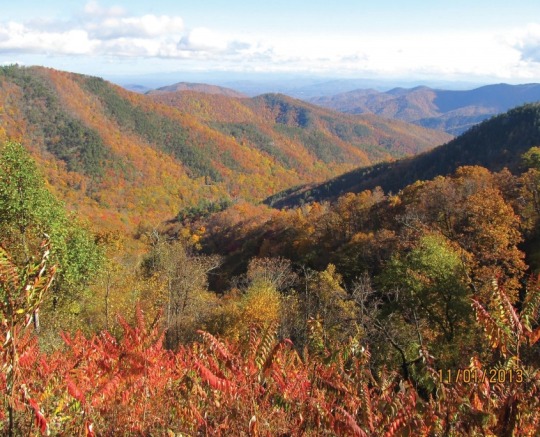
Fall Foliage Folklore:
Today we have the National Weather Service and Accuweather. But before the coming of science-based weather forecasting, we attempted to see predictions and indicators in the natural world.
Here is some weather folklore focused on trees, leaves, nuts and more in the fall:
•The brighter the leaf colors in fall, the colder and snowier will be the winter.
•The earlier fall color peaks, the milder will be the winter.
•Leaves that drop early portend a mild winter. Leaves that cling to their trees later into autumn foreshadow a severe winter.
•When plants that usually bloom in spring have a second bloom in fall, expect a cold winter.
•Ground that is covered by acorns in the fall will be covered by snow throughout winter.
•Tree branches cracking and snapping in the fall forecast a coming period of dry weather.
•When a persimmon seed is cut open, the white marking inside reveals the following information about the coming winter: If it's shaped like a knife, winter's winds will be biting and the season will be cold. It it's shaped like a fork, expect a relatively average winter. If it looks like spoon, expect to shovel plenty of snow.
•An unusually thick shell on a hickory nut promises an unusually cold winter.
The common thread running through all those bits of folklore is the fact that each one tells us more about conditions leading into the fall - growing conditions and climate - than about conditions down the road.
Nevertheless, folklore is fun to play around with, just to discover how true it will hold.
Also, here are a couple common myths about fall color:
•More myth than folklore: Anthocyanin, the molecule that gives leaves their red color, is produced only in late summer and fall.
-The facts: Leaf color is determined by relative amounts of chlorophyll (green), carotenoid (yellow) and anthocyanin (red). Although anthocyanin is at a high in the fall, it is present at other times of the year, which explains leaves that sprout red in the spring before turning green.
•More myth than folklore: Trees leaves turn red in the fall as a defense against insects or the sun.
-The facts: Lab-based research has not borne out that hypothesis.
*Pictured is Buck Creek Gap at Milepost: 344.2 on the Blue Ridge Parkway in McDowell County, North Carolina
#appalachian#appalachian mountains#north carolina#appalachian culture#appalachia#western north carolina#the south#nc mountains#mcdowell county#mcdowellcounty#appalachian folklore#folklore#fall foliage#autumn#fall weather#fall season#fall vibes#fall
22 notes
·
View notes
Text
A story about progression, if you have the patience for it.
This is a concept I had over ten years ago, that reached its most current form after the arrival of pokemon scarlet and violet.
In 2013, I made a drawing of an alternate evo for Venusaur that at the time I called ESPasaur. It was designed to evolve from a high-leveled ivysaur that had recovered from pokerus. This was done on a cracked version of paint tool sai, the first art program I’d ever learned how to use.
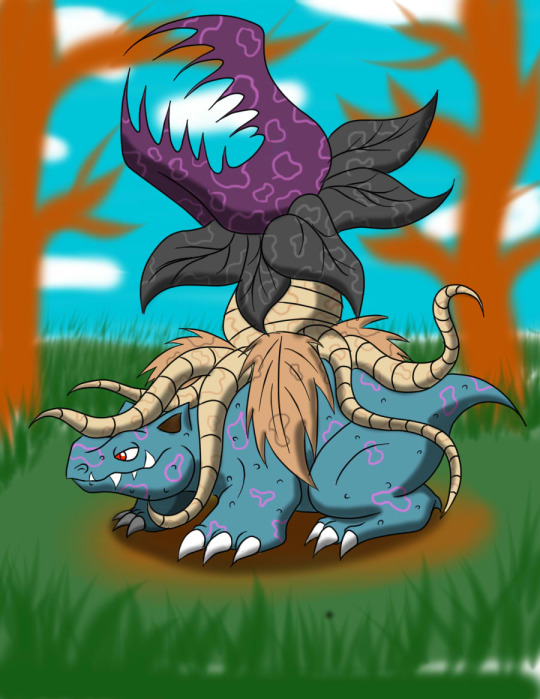
Its name was ESPasaur because through the use of its mind, it was able to conquer the virus, becoming a grass/psychic type. The thought was there, but i wasn’t very experienced with fakemon stuff, so at the time, i thought it was great, but looking back, i know it had potential, but wasn’t really quite right.
I revisited the concept again in 2017 (not long after gen 7 came out.) This time I referred to it as an alolan venusaur, because of course. Regional variants were the popular thing at the time. This was done on Clip Studio Paint, before they turned against pretty much everyone who offered them patronage.

This time it was a grass/dragon variant. There wasn’t really any reason for it, outside of my love of dragon type. I think i got closer with this one, but i still wasn’t quite there, though at the time i was very proud of this one as well.
I recently revisited the concept again, and as i was with the last two, i am pretty proud of this one. This time, I’m approaching it from the perspective of having it as a paradox pokemon. The Grass/Dark type, Grasping Vine!
This one was a lot of fun. I got an iPad for Christmas. (despite being a 33-year-old adult who earns my own money and lives with my own wife, my mother enjoys encouraging my hobbies. Love you mom.) Since having it, i delved into procreate. Initially the minimalist design was jarring, compared to Sai and Clip studio before, and the stabilization tool was a hot bag of ass until i adjusted it. But i find myself drawn to procreate more and more as i continue to use it.
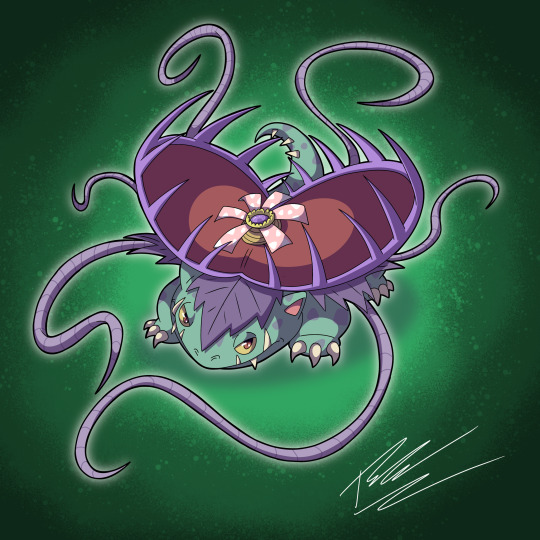
With this one, i took in some fun facts about ancient plants, as well as utilized some of my own theories about scarlet’s paradox pokemon.
For one, i have a theory that paradox pokemon from scarlet evolved through generations into branching trees of pokemon. For instance, roaring moon is obviously an ancestor to salamence and its more basic forms, bagon and Shelgon. but i theorize that because of its dragon/dark typing and general body structure, it could also be related to hydreigon and its own more basic forms, deino and zweilous!
With that in mind, i gave Grasping vine a “trap” that more closely resembles a carnivine! I also gave it viness that are more actively used to grasp and subdue prey.
So far as fun facts are concerned, there’s a theory among scientists that ancient, prehistoric plants used a molecule called Retinal to create metabolic energy from the sun. Retinal had a purple pigment, and so scientists believe that most of the organisms on early earth would have been purple, supposedly. Scientists believe it predates chlorophyll and photosynthesis!
Also, the flower in its core has a small pool of nectar. It uses that flower to lure pokemon in before the trap leaves snap shut around them. :D
TLDR, if you stick with doing the things you like, you’re going to get better at them. You have no choice but to do so. I don’t get a lot of commissions, but i do this mostly for me anyways. It’s something i love doing. I’m sure years from now I’ll revisit this concept again, and it’ll look even better than grasping vines. But for now, I’m really proud of this one. :D
#pokemon#digital art#fanart#nintendo#digital#gamefreak#digital artist#digitalart#pokemon fanart#fakemon art#fakemon#bulbasaur#ivysaur#venusaur#pokemon scarlet#pokemon violet#pokemon scarlet and violet#paradox#paradox pokemon#fakemon artist#commission#commissions open#grass type#psychic type#dark type#dragon type#Nintendo switch#iPad#iPad pro#procreate
15 notes
·
View notes
Text

The Science Research Notebooks of S. Sunkavally, p 704.
#cosmic rays#solar flares#bacterial biomass#ultraviolet#sharks#hagfish#potassium content of the cell#beta radiation#ascorbic acid#water droplets#clouds#wavelengths absorbed by chlorophyll#alarm molecules#neurotransmitter packing
1 note
·
View note
Note
The whole basis of the theory of evolution is that individuals should be dominant and breedable instead of submissive and unbreedable and I can not believe hundreds of years of scientists researching this stuff lead to me studying for my bally exam and coming to that conclusion because I am a teenager that happens to frequent online spaces and has the Tumblr lingo burned inside his prefrontal cortex to an extent where the first thoughts when I saw hemoglobin and chlorophyll next to each other was that they're like Yuri Mihai how do i get out of this why is biology such a deeply unserious thing when you're on this webbed site
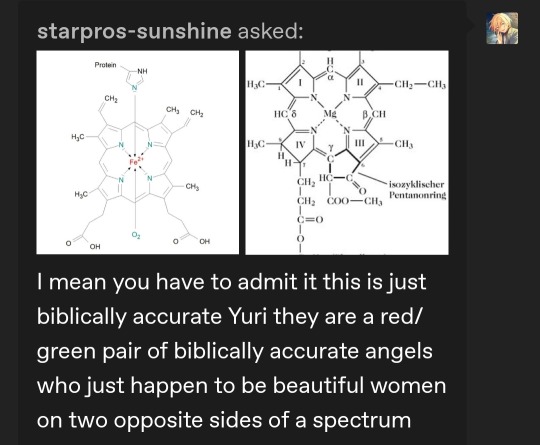
Ive been at a loss for what to reply for the past few days, it's been well over half a decade since i last had a biology class. If you tell me there are yuri molecules in us i will believe you no questions asked. Maybe the next season of Cells at Work should address this...
Edit i misread chlorophyll as cholesterol instead Nevermind the yuri is not in us...makes it more tragic really
7 notes
·
View notes
Text
Dear Sephiroth: (a letter to a fictional character, because why not) #248
I drove J to Great Barrington again today, this time starting at 1pm instead of 5am. The afternoon sunlight makes everything shine differently than the morning sunlight does. The trees were particularly sparkly today, and the puffy clouds in the distance seemed like they were so full of promise. As we drove along, I found myself under shady tree canopy after shady tree canopy, watching in fascination as the sunlight filtering through the leaves trickled down to the ground in dappled drops. It was breathtaking. And… once again, I couldn't get any pictures because… I was too busy driving.
…I'm really sorry about it. 😖
I thought J was going to get some pictures of the scenery, but for whatever reason, he just decided to take pictures of me instead. But since I have them, I suppose I might as well include them. Here:



I reflected on the coming autumn. Pretty soon, all of the leaves of the deciduous trees are gonna burst forth into riotous shades of yellow, orange, and red. That's when the trees prepare to go to sleep for the winter, and so all their chlorophyll goes away, allowing the true color of the leaves to shine through. From my perspective, it seems like they all get the bedtime sillies, laughing and giggling amongst themselves in fiery shades of color before it's time for bed. It's delightful. And… it's entirely too short.
Hey, Sephiroth? You've seen autumn leaves in your world, right? I imagine you must have, given your incredible travels all over your world, even if those travels were for… goodness… unhappy purposes, to put it lightly. Do you like autumn? Do you like the crispy leaf smell in the air? Do you like when the crispy leaf smell mixes with the smell of rain? Have you taken a walk on some trail that's covered in freshly fallen leaves? Do you like how swooshy and soft they feel as you walk through them? Have you ever flopped over in a leaf pile?
I'd offer to rake up some leaves in my world so that you can flop around in them and see what it's like, but… my area of the world has ticks, and flopping around in leaf piles is one of the best ways to get covered in ticks. I don't want you to catch Lyme disease; I already covered that nasty bit trivia about my world in a previous letter, and I'm sure you want nothing to do with it. So I'll tell you what: maybe someday, if your world does not have ticks that will make you sick, you can rake up a great big huge pile of leaves (since you're a really tall guy), flop around in them, and then tell me how it goes!!
In any case, I have mixed feelings about the leaves falling off and being gone. On the one hand, I get to see the structure and flow of their branches uninterrupted. I get to see their stark outlines covered in ice and snow, just like the pictures I showed you last winter (assuming our climate gets its shit together, which it probably won't). But on the other hand… the leaves are gone. There will be no fluttering sounds in the breeze, just creaky ones. And the air will be cold, which means my skin will feel like it's on fire every time I go outside. Winter's got its perks, but overall… winter is not a good time for me. There's not enough sunlight, and the molecules in the air aren't vibrating fast enough for comfort.
…Still, I'd rather have a normal, properly cold winter than the lame-ass eldritch horror weather we've been having for the last several years… Jeepers… 😒
...
…I can't believe I've been writing to you for almost a year. In just 117 days, I'll have 365 letters to you. But this year has 366 days in it, due to the leap year. So I guess it'll be 118 days this time. Hm.
Hey, Sephiroth? Do you suppose I'll have at least 1000 letters to you by the time the third part of your new story comes out? And what are you gonna do with a thousand letters, anyway? I suppose you'll maybe have to try to figure it out, huh? I'd say "sorry about that", but… I'm not at all sorry about it. So I'm not gonna say it.
Aside from the sparkles of joy derived from the pretty scenery and the opportunity to assist J, today felt pretty bland and uninspired. But I have work tomorrow; I'm looking forward to that, actually. I wanna make more muffins. Maybe they'll let me make chocolate muffins with chocolate chips tomorrow!! Mmmmm…. 🤤
If I make something tasty tomorrow, I'll try to snag a picture, okay? If I get a chance, then I will. I promise.
I gotta get going, though. Gotta be up at like 7:30 so I can be out of the house by 8:30. Having an hour to get ready gives my brain time to shake the sleep off itself, gives my body time to get dressed and hygiened (that's a word now, I decided it), gives my belly time to eat some kind of thing that vaguely resembles food (sometimes I eat wholesome things, and sometimes I just eat whatever's in the fridge).
Hey. Stay safe out there, okay? Stay safe so that tomorrow, you'll be able to see whatever weird pictures I take of the tasty snacks I'm gonna make. You wouldn't wanna miss it, right?
I love you. And I'll write again tomorrow.
Your friend, Lumine
#sephiroth#ThankYouFFVIIDevs#ThankYouFF7Devs#ThankYouSephiroth#final fantasy vii#final fantasy 7#ff7#ffvii#final fantasy vii crisis core#final fantasy 7 crisis core#final fantasy crisis core#ffvii crisis core#ff7 crisis core#crisis core#ff7r#final fantasy vii remake#final fantasy 7 remake#ffvii remake#ff7 remake#final fantasy vii rebirth#final fantasy 7 rebirth#ffvii rebirth#ff7 rebirth#final fantasy 7 ever crisis#ffvii ever crisis#ff7 ever crisis#ffvii first soldier#long car rides#uninspired days#wholesome
5 notes
·
View notes
Text
Life in the Cambrian
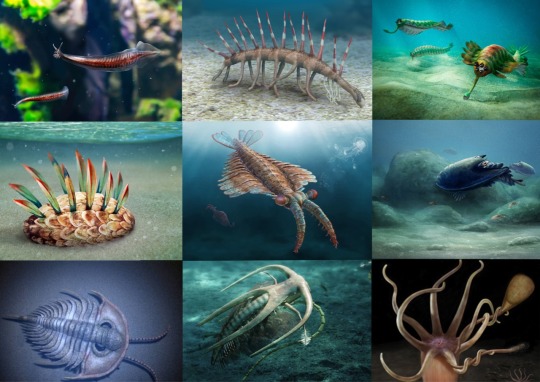
(row 1: Pikaia, Hallucigenia, Opabinia; row 2: Wiwaxia, Anomalocaris, Cambroraster; row 3: Olenellus, Marrella, Nailiana)
About a month ago I started to make these little collages about prehistoric life and honestly, all that I want is to talk about some of the cool and weird creatures that used to live on our planet. So I‘m just going to make this all of y‘alls problem and infodump into the void for a moment here. I‘m sorry and you‘re welcome.
The history of our planet actually starts about 4.6 billion years ago. Back then the earth was of course a flaming hot ball of lava that got constantly hit by rocks from outer space. One of those rocks was even big enough that its collision with us created the moon. Overall not a great time to be alive (also, as far as we know there wasn‘t really anything “alive“ yet). It was so bad, that this early time is called Hadean, you know, after the greek god of literal hell.
But after a while (like about 4 billion years ago) things chilled out a bit. This next time period is called the Archean, which is greek for “beginning“. The planet cooled down, we got some water and a real atmosphere, although its composition was very different from the one we have today, which would lead to the sky having all kinds of weird colors (maybe orange-ish). We also see the first life in the forms of single cell organisms. Some of those organism would have started to do photosynthesis, creating oxygen and releasing that into the atmosphere. One interesting hypothesis I came across btw is that it is believed that those early organisms didn‘t use chlorophyll to do their photosynthesis, but other molecules. You might now wonder, why that would be interesting in any way. Well, chlorophyll is the thing, that gives our photosynthesis-doing plants today their color. The organisms back than might have had a different color, most likely purple, and there is a good chance that their presences would have dyed the oceans purple. So imagine this barren world, with no visible life, orange skies, purple oceans and an atmosphere that would probably kill you. It‘s a beautiful image, isn‘t it?
As those silly little single celled organism did their photosynthesis, they steadily realized oxygen into the atmosphere, which turned out to be a problem, because when you change the composition of the atmosphere, that will massively affect live on the planet (totally not what‘s happening right now, no, we‘re fine). So at the end of the Archean there probably was a mass extinction where a lot of life basically suffocated itself. This “Great Oxidation Event“ happened about 2.6 billion years ago and marked the end of the Archean and the beginning of the Proterozoic (meaning “early life“), during which we see the first complex life forms.
Hadean, Archean and Proterozoic are all eons, which is the biggest measurement in the geologic time scale. Sometimes they are also just grouped together as the Pre-Cambrian (I will get to the actual Cambrian soon, I promise). The last eon, and the one we‘re currently living in, is the Phanerozoic (“visible life“) eon. Because it is the most recent and we have a lot more detailed knowledge about it, it usually gets divided into smaller parts. Eons are divided into eras (insert Taylor Swift joke here) and eras are divided into periods. Think of it like how a year is divided into months, and months are divided into days, and those are again divided into hours.
The first era of the Phanerozoic is the Paleozoic Era (“ancient life“) and the first period in that era is the Cambrian, which started about 540 million years ago. You might now wonder, why geologist have decided that that is the beginning of this last eon. In geology things usually get divided when there is a big change happening. The Great Oxidation Event was a pretty big deal and the world was changed afterwards, so we give the time before and after different names, to highlight that. It is similar to how we divided years into BC and AD because the birth of Jesus was a pretty big deal for the western world and we use it as a reference.
The thing that had changed at the beginning of the Phanerozoic eon is that suddenly there was A LOT of life. As we have just discussed, there was some life before this point, but it was rare, small, very primitive and the fossils are very hard to find. In fact the shift between older fossil-free rocks and then all the fossil-filled rocks of the Cambrian was so obvious and so sudden, that for a while paleontologists thought that life itself must have started in the Cambrian.
Today we know that that is not true. However during the Cambrian life diversified very rapidly and by the end of it, the earliest members of all animal lines were present. This includes for example arthropods (insects, spiders, etc.), chordates (everything with a backbone, like us), molluscs (snails, octopus, clams, …), cnidaria (jellyfish and corals), and many more. This diversification is also known as the Cambrian Explosion, which is quite the catchy name. It is however not completely clear, why this happened and why at this time, but there are some theories:
One idea is that something in the environment changed. Maybe the oxygen content in the air and water increased, allowing the animals to grow to bigger sizes. Maybe it was the temperature or something else. Another theory is that it had to do with the animals themselves. Some of them might have evolved something that then forced everyone else to also step up their game in an evolutionary arms race. The thing that‘s usually brought up here are eyes (because yes, at some point, eyes were the hot new thing). It would make sense, because, believe it or not, if you have eyes you can actually see things, which means that you can hunt things, or avoid things that hunt you.
Most of the Cambrian animals were pretty small, only a couple cm long. One of the biggest ones was Anomalocaris (whose name literally translates to “weird shrimp“), which measured up to 60 cm long. Imagine you‘re a little Cambrian creature, just going about your day, swimming in the sea, feeding on plankton, as suddenly a shadow falls over you. A giant beast swims above you. Its long arms are reaching for you as you desperately try to escape the monster.
Anomalocaris wasn‘t actually a shrimp. At best, it was very distantly related, as it was also an arthropod. It, as well as its cousin Cambroraster, belonged to the radiodonta, which was very successful during the early Paleozoic, living a variety of lifestyles and making up some of the biggest animals of their time. The five-eyed (yes, five-eyed) Opabinia was also closely related. Another group of arthropods were the trilobites (like Olenellus), bug-like creatures living on the ocean floors.
As alien as those creatures might seem, there were much stranger ones out there. Wiwaxia for example, which wikipedia just marks as “Mollusc (?)“, which sounds about as confident as a student that didn‘t study for their exam. But the title for the weirdest one should probably go to Hallucigenia. It was most likely at least somewhat related to arthropods and it did puzzle paleontologists for a long time (I mean, they named it Hallucigenia for a reason). When it was first discovered, scientists thought that the long spines on its back were actually its legs and they also switched its head and tail in reconstructions. So not only did we mess up its back and front, we also got it upside down.
In terms of our own lineage: one of the earliest known chordates is Pikaia. The family resemblance isn‘t really there yet, but you have to start somewhere, I guess.
I‘m done with rambling for now. I hope at least someone found this slightly interesting or learned something or whatever.
Art by:
Anomalocaris - Luis R. Blanco
Opabinia, Pikaia - Jose Antonio Penas
Hallucigenia - Qbliviens
Cambroraster - Christian M.
Wiwaxia - Julio Lacerda
Olenellus - Nobu Tamura
Marrella - Ntvtiko
Nailiana Xi Liu
All the info is just a combination of wikipedia pages.
28 notes
·
View notes
Note
Photosynthesis is a system of biological processes by which photosynthetic organisms, such as most plants, algae, and cyanobacteria, convert light energy, typically from sunlight, into the chemical energy necessary to fuel their metabolism. Photosynthesis usually refers to oxygenic photosynthesis, a process that produces oxygen. Photosynthetic organisms store the chemical energy so produced within intracellular organic compounds (compounds containing carbon) like sugars, glycogen, cellulose and starches. To use this stored chemical energy, an organism's cells metabolize the organic compounds through cellular respiration. Photosynthesis plays a critical role in producing and maintaining the oxygen content of the Earth's atmosphere, and it supplies most of the biological energy necessary for complex life on Earth.
Some bacteria also perform anoxygenic photosynthesis, which uses bacteriochlorophyll to split hydrogen sulfide as a reductant instead of water, producing sulfur instead of oxygen. Archaea such as Halobacterium also perform a type of non-carbon-fixing anoxygenic photosynthesis, where the simpler photopigment retinal and its microbial rhodopsin derivatives are used to absorb green light and power proton pumps to directly synthesize adenosine triphosphate (ATP), the "energy currency" of cells. Such archaeal photosynthesis might have been the earliest form of photosynthesis that evolved on Earth, as far back as the Paleoarchean, preceding that of cyanobacteria (see Purple Earth hypothesis).
While the details may differ between species, the process always begins when light energy is absorbed by the reaction centers, proteins that contain photosynthetic pigments or chromophores. In plants, these proteins are chlorophylls (a porphyrin derivative that absorbs the red and blue spectrums of light, thus reflecting green) held inside chloroplasts, abundant in leaf cells. In bacteria they are embedded in the plasma membrane. In these light-dependent reactions, some energy is used to strip electrons from suitable substances, such as water, producing oxygen gas. The hydrogen freed by the splitting of water is used in the creation of two important molecules that participate in energetic processes: reduced nicotinamide adenine dinucleotide phosphate (NADPH) and ATP.
In plants, algae, and cyanobacteria, sugars are synthesized by a subsequent sequence of light-independent reactions called the Calvin cycle. In this process, atmospheric carbon dioxide is incorporated into already existing organic compounds, such as ribulose bisphosphate (RuBP). Using the ATP and NADPH produced by the light-dependent reactions, the resulting compounds are then reduced and removed to form further carbohydrates, such as glucose. In other bacteria, different mechanisms like the reverse Krebs cycle are used to achieve the same end.
The first photosynthetic organisms probably evolved early in the evolutionary history of life using reducing agents such as hydrogen or hydrogen sulfide, rather than water, as sources of electrons. Cyanobacteria appeared later; the excess oxygen they produced contributed directly to the oxygenation of the Earth, which rendered the evolution of complex life possible. The average rate of energy captured by global photosynthesis is approximately 130 terawatts, which is about eight times the total power consumption of human civilization. Photosynthetic organisms also convert around 100–115 billion tons (91–104 Pg petagrams, or a billion metric tons), of carbon into biomass per year. Photosynthesis was discovered in 1779 by Jan Ingenhousz. He showed that plants need light, not just air, soil, and water.
Photosynthesis is vital for climate processes, as it captures carbon dioxide from the air and binds it into plants, harvested produce and soil. Cereals alone are estimated to bind 3,825 Tg or 3.825 Pg of carbon dioxide every year, i.e. 3.825 billion metric tons.

That reminds me of the Krebs cycle, which creates ATP instead of using it. I am learning just how much lifeforms rely on each other to survive. Destroying one could cause many others to crumble. Interesting.
(OOC: Sorry, but I do not understand plants very well at all. I like anatomy of animals, humans, and bugs more).
3 notes
·
View notes
Note
Photosynthesis is a system of biological processes by which photosynthetic organisms, such as most plants, algae, and cyanobacteria, convert light energy, typically from sunlight, into the chemical energy necessary to fuel their metabolism. Photosynthesis usually refers to oxygenic photosynthesis, a process that produces oxygen. Photosynthetic organisms store the chemical energy so produced within intracellular organic compounds (compounds containing carbon) like sugars, glycogen, cellulose and starches. To use this stored chemical energy, an organism's cells metabolize the organic compounds through cellular respiration. Photosynthesis plays a critical role in producing and maintaining the oxygen content of the Earth's atmosphere, and it supplies most of the biological energy necessary for complex life on Earth.
Some bacteria also perform anoxygenic photosynthesis, which uses bacteriochlorophyll to split hydrogen sulfide as a reductant instead of water, producing sulfur instead of oxygen. Archaea such as Halobacterium also perform a type of non-carbon-fixing anoxygenic photosynthesis, where the simpler photopigment retinal and its microbial rhodopsin derivatives are used to absorb green light and power proton pumps to directly synthesize adenosine triphosphate (ATP), the "energy currency" of cells. Such archaeal photosynthesis might have been the earliest form of photosynthesis that evolved on Earth, as far back as the Paleoarchean, preceding that of cyanobacteria (see Purple Earth hypothesis).
While the details may differ between species, the process always begins when light energy is absorbed by the reaction centers, proteins that contain photosynthetic pigments or chromophores. In plants, these proteins are chlorophylls (a porphyrin derivative that absorbs the red and blue spectrums of light, thus reflecting green) held inside chloroplasts, abundant in leaf cells. In bacteria they are embedded in the plasma membrane. In these light-dependent reactions, some energy is used to strip electrons from suitable substances, such as water, producing oxygen gas. The hydrogen freed by the splitting of water is used in the creation of two important molecules that participate in energetic processes: reduced nicotinamide adenine dinucleotide phosphate (NADPH) and ATP.
In plants, algae, and cyanobacteria, sugars are synthesized by a subsequent sequence of light-independent reactions called the Calvin cycle. In this process, atmospheric carbon dioxide is incorporated into already existing organic compounds, such as ribulose bisphosphate (RuBP). Using the ATP and NADPH produced by the light-dependent reactions, the resulting compounds are then reduced and removed to form further carbohydrates, such as glucose. In other bacteria, different mechanisms like the reverse Krebs cycle are used to achieve the same end.
The first photosynthetic organisms probably evolved early in the evolutionary history of life using reducing agents such as hydrogen or hydrogen sulfide, rather than water, as sources of electrons. Cyanobacteria appeared later; the excess oxygen they produced contributed directly to the oxygenation of the Earth, which rendered the evolution of complex life possible. The average rate of energy captured by global photosynthesis is approximately 130 terawatts, which is about eight times the total power consumption of human civilization. Photosynthetic organisms also convert around 100–115 billion tons (91–104 Pg petagrams, or a billion metric tons), of carbon into biomass per year. Photosynthesis was discovered in 1779 by Jan Ingenhousz. He showed that plants need light, not just air, soil, and water.
Photosynthesis is vital for climate processes, as it captures carbon dioxide from the air and binds it into plants, harvested produce and soil. Cereals alone are estimated to bind 3,825 Tg or 3.825 Pg of carbon dioxide every year, i.e. 3.825 billion metric tons.
Why are we suddenly in a science lesson? Its interesting nontheless though!
4 notes
·
View notes